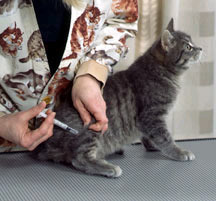By: Alli Biddick
Oklahoma State University, Class of 2012
This Spring, the Oklahoma State University SVECCS Chapter was awarded a grant by SAVMA Education and Professional Development Committee to hold a wetlab for the students entitled "Tubology". We believe that SVECCS provides students with an invaluable opportunity to get practice with hands-on techniques. We strive to teach students how to do practical things in a clinic setting (that they won't get to do in class), with an emphasis on emergency techniques! The wetlab was held on Saturday, November 13, 2010. Thirteen students attended, with the majority being first and second year veterinary students. We had four instructors present: three clinicians in our teaching hospital (Boren Veterinary Medical Teaching Hospital) and the head RVT at the teaching hospital.
We had cadavers set up at four different stations. At one station, the students learned how to properly place and suture chest tubes. This is vitally important for animals who present with pneumothorax and are in need of emergency chest evacuation! The next station was set up to allow students to practice inserting urinary catheters into male and female dogs (a technique every veterinarian will learn to love). The third station was all about esophagostomy tubes! This is a very important procedure in critically ill animals who cannot eat on their own. The final station, led by our head RVT, taught the students how to place central lines in the jugular vein of dogs. The students had so much fun learning about the various "tubes" and when they are indicated. The lab was a great hit for all who attended! The students feel they now possess extra knowledge that will help them when they are working this summer, when they are fourth year students, and of course throughout their career! OKSTATE SVECCS would like to thank SAVMA EPDC for helping make this lab possible!!
 Saturday, February 5, 2011 at 01:00PM
Saturday, February 5, 2011 at 01:00PM Remembering perspective is, perhaps, the best way to deal with stress. As exams were wrapping up this December, I was thinking about wrapping up presents and packing a suitcase as I bragged to “less fortunate” classmates whom I knew were scheduled in the clinic on the holiday. I boasted that I would be home, with my family, enjoying my time off. Instead of surprises in the form of many glorious gifts, I was visited by the Ghost of Christmas Irony as I, too, spent several hours at the emergency animal hospital with my own dog, all night on December 25th. In short, she apparently decided it was Santa who had left her a small box of Dove Dark Chocolate Truffles under the tree, not one of my relatives who had, in fact, accidentally left it unattended while we were all away.
 Cornell,
Cornell,  Small animal in
Small animal in  Life as a Vet Student
Life as a Vet Student 
